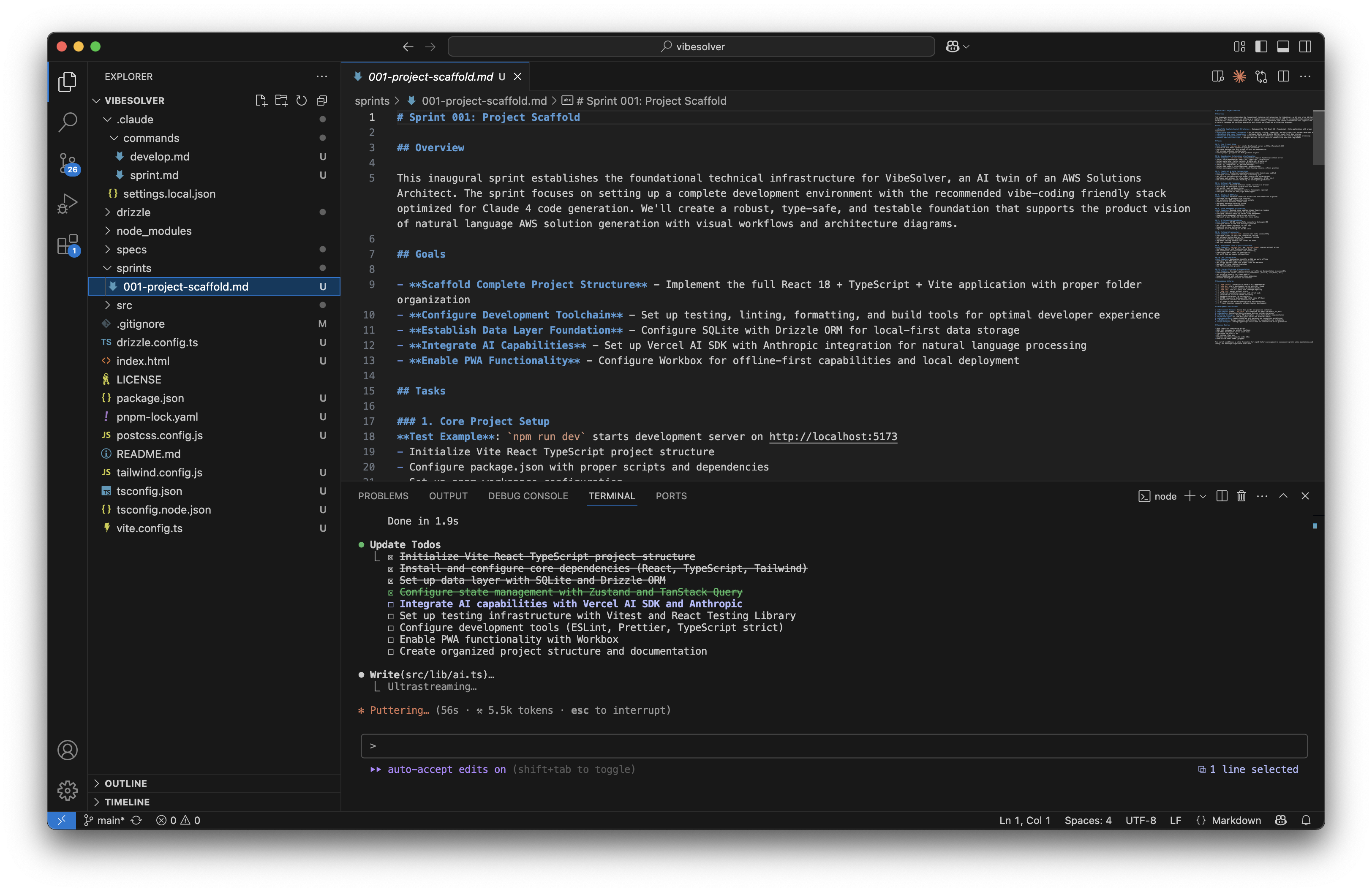
AI-Powered MVP Development: Building VibeSolver with Vibe-Friendly Technology Stack
Scroll to explore
Building on the product vision for VibeSolver, the next critical step is selecting a technology stack that enables rapid development while maintaining high code quality. This approach prioritizes “vibe-friendly” technologies that work seamlessly with AI-assisted development tools like Claude 4.
Vibe Friendly Stack
Here is the prompt I use to create the vibe friendly stack definition.
Ultrathink to recommend a minimal technical stack for an app which meets the following criteria:
- The stack is vibe coding friendly using Claude 4 which means the model knows the stack technologies really well and can generate and iterate high quality code with simply natural language instructions
- The app can run local-first on a mac laptop and can connect to APIs for online services
- The stack can use latest AI frameworks, libraries, SDKs with ease
- The stack uses minimal lines of code to generate same functionality compared to alternative stacks
- The stack uses stable and well documented frameworks, libraries, and packages
- The stack is easy and fast to test, build, run, and debug
Here is the vibe friendly stack recommended by Claude. I save both the generated stack and prompt as specs/stack.md in my project.
Core Stack
Runtime & Build:
- Node.js (latest LTS) + pnpm - Excellent Claude support, vast ecosystem, fast package management
- Vite - Lightning-fast dev server, minimal config, excellent TypeScript support
- TypeScript (strict mode) - Type safety with minimal overhead, Claude generates high-quality TS code
Frontend:
- React 18+ with hooks - Claude has deep React knowledge, minimal boilerplate with modern patterns
- Tailwind CSS - Utility-first, extremely concise styling, Claude excels at Tailwind generation
Local Data:
- SQLite with better-sqlite3 - Perfect for local-first, zero-config, excellent performance
- Drizzle ORM - Type-safe, minimal SQL abstraction that Claude handles beautifully
AI Integration Layer
AI SDK:
- Vercel AI SDK - Unified interface for multiple providers, streaming support, React hooks
State & Data Management
Client State:
- Zustand - Minimal Redux alternative, ~100 lines vs 1000+ with Redux
- TanStack Query - Server state management, caching, background updates
Offline/Sync:
- Workbox (for PWA) - Local-first capabilities
Development Tools
Testing:
- Vitest - Fast Vite-native testing, Jest-compatible API
- React Testing Library - Component testing with minimal setup
Code Quality:
- ESLint + Prettier - Automated formatting and linting
- TypeScript strict mode - Compile-time error catching
Why This Stack Excels:
- Claude-Friendly: I have extensive knowledge of React/TS/Tailwind patterns and can generate production-quality code
- Local-First: SQLite + Workbox/Tauri enables true offline functionality
- AI-Ready: Vercel AI SDK provides seamless integration with all major AI providers
- Minimal Code: Tailwind utilities, React hooks, and Zustand reduce boilerplate by 60-80%
- Battle-Tested: Every component is mature with excellent documentation
- Developer Experience: Vite’s HMR, TypeScript intellisense, and Vitest’s speed create a smooth development flow
Starter Command:
pnpm create vite my-app --template react-ts
cd my-app
pnpm add ai @ai-sdk/openai @anthropic-ai/sdk zustand @tanstack/react-query better-sqlite3 drizzle-orm
pnpm add -D tailwindcss postcss autoprefixer vite-plugin-pwa workbox-window npx tailwindcss init -pThis stack lets you build complex AI-powered applications with surprisingly few lines of code while maintaining excellent type safety and developer experience. Claude can iterate on this stack extremely effectively due to its deep familiarity with these technologies.
Design Philosophy
I also note the specific design requirements for VibeSolver as specs/design.md file in the project.
The VibeSolver web app should be designed with latest UI design system to provide a modern, reactive, easy, usable, and visual interface to achieve the intended requirements of the product. The design system and UI is inspired by Figma Infinite Canvas UI where user can design using drag and drop on an infinite canvas and Voiceflow Visual Workflow editor where user can visually connect steps of a workflow and run the workflows step by step.
Integration with Trenddit Ecosystem
This vibe-friendly stack approach aligns perfectly with Trenddit’s philosophy of lean AI automation:
Trenddit Memo Synergy:
- Technology Selection: Use similar stack principles for consistent development experience
- AI-First Development: Leverage Claude’s deep knowledge of these technologies
- Rapid Prototyping: Enable quick iteration and testing of new features
- Knowledge Sharing: Document stack decisions for team learning
Ecosystem Benefits:
- Unified Development: Consistent tooling across all Trenddit products
- Shared Learning: Stack expertise transfers between projects
- Rapid Development: Proven patterns accelerate new feature development
- AI Optimization: Technology choices optimized for AI-assisted development
By selecting vibe-friendly technologies, development teams can achieve remarkable productivity gains while maintaining code quality and system reliability. The key is choosing tools that AI models understand deeply, enabling more accurate code generation and faster iteration cycles.
